|
|
|
Summer 2022
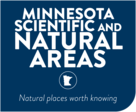
Nature Notes is the Minnesota Scientific and Natural Areas quarterly newsletter. Here's what's in store this issue!
|
Peatland Butterflies of Northern Minnesota
Kyle Johnson, Minnesota Biological Survey
Our northern peatlands (bogs and fens) harbor a wonderful diversity of moths and butterflies – over 1,100 species identified to date – some of which are typical inhabitants of sub-arctic and arctic regions. Step into a northern Minnesota peatland and you may encounter some of the same species that you would see in Churchill, Manitoba or Fairbanks, Alaska.
This photo essay looks at some of our more specialized peatland butterflies. Butterflies are a group of moths (superfamily Papilionoidea) just as owls are a group of birds. All butterflies are moths, while not all moths are butterflies. We may explore the non-butterfly moths (which account for most of the diversity) in future articles.
May and June are the best times to see many of these boreal specialists, when there is flurry of closely spaced emergences (when butterflies emerge from their chrysalis). The flight period of some species can be very brief, coming and going in less than ten days, especially in hot and sunny weather. Summer species are more spaced out and have slightly longer flight periods.
Large peatland SNA’s can be amazing places to see these butterflies, although it may take some grit to view them, between the slogging and biting flies. The chance to see amazing species in amazing landscapes is more than worth the effort; just be sure to prepare for navigating remote places and carry plenty of bug spray!
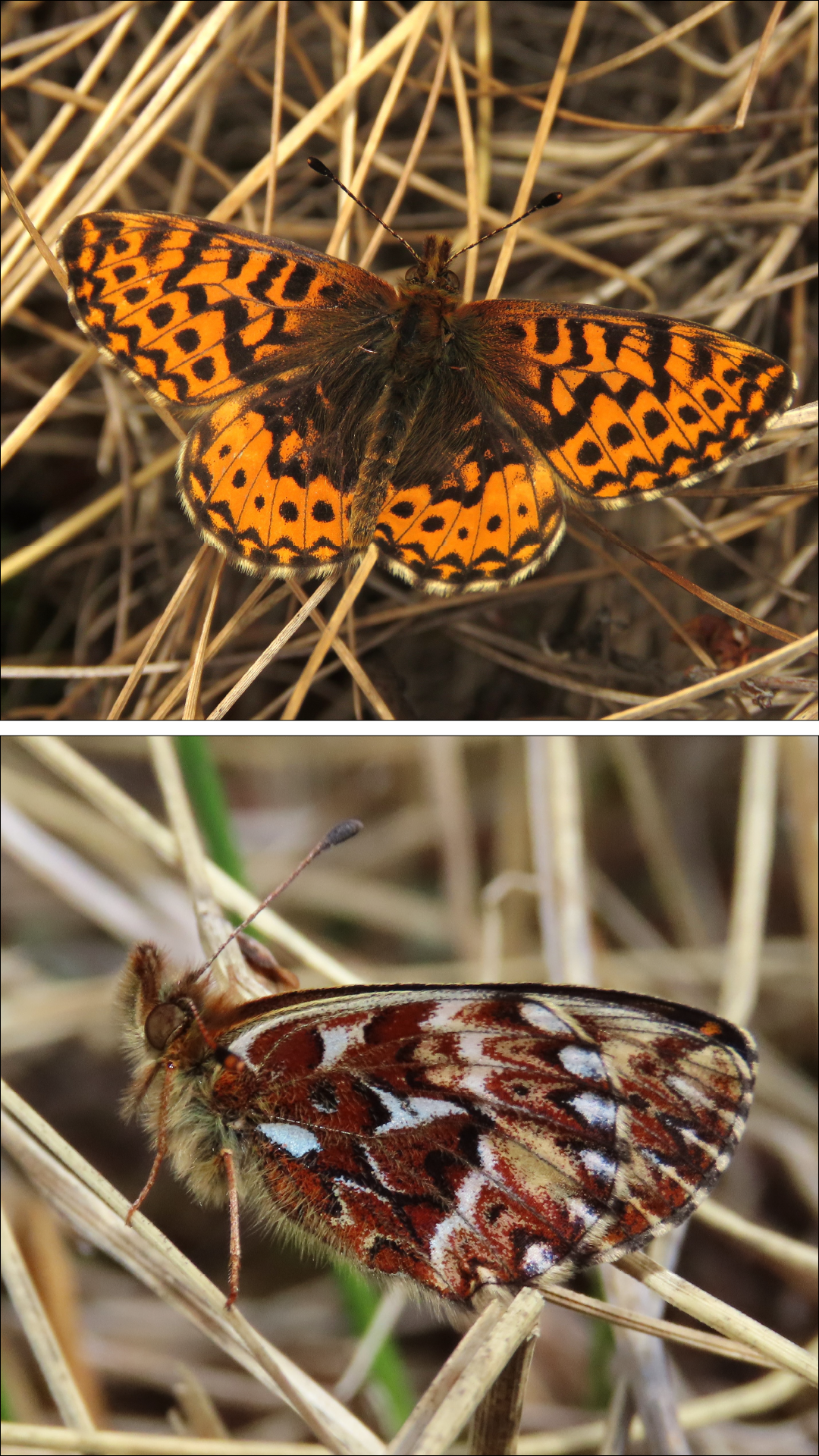 Freija Fritillary (Boloria freija). Photo by Kyle Johnson.
Freija Fritillary (Boloria freija) is one of the earliest peatland butterflies, along with the much more widespread Brown Elfins (Callophrys augustinus) and Spring Azures (Celastrina lucia). The first adults are typically on the wing in early May. When finding Freija you may feel ice underfoot in the sparsely treed hummocky bogs they call home. Although rarely seen by people, they are ubiquitous in the large peatland SNA’s which have raised bogs. Freija Fritillary has been found in the East Rat Root River Peatland, Hole in the Bog Peatland, Lost Lake Peatland, Myrtle Lake Peatland, North Black River Peatland, Red Lake Peatland, Sand Lake Peatland, Wawina Peatland, and West Rat Root River Peatland.
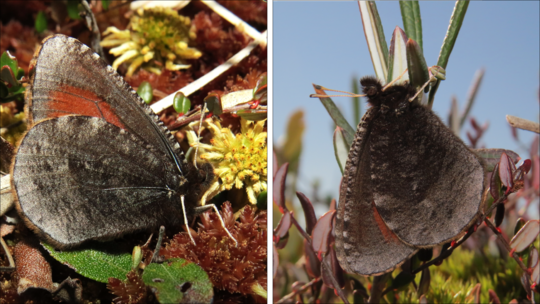 Red-disked Alpine (Erebia discoidalis). Photo by Kyle Johnson.
Red-disked Alpine (Erebia discoidalis) takes flight not long after Freija Fritillary and can often be found flying together where their habitats overlap, such as the edges of raised bogs. Red-disked Alpines also like more mineral-rich habitats such as ribbed fens, as long as they are not too wet. Males often sit on gravel roads near peatlands, where they seek salts and other nutrients. Red-disked Alpine has been found in the East Rat Root River Peatland, Lost Lake Peatland, Lost River Peatland, Luxemberg Peatland, Mulligan Lake Peatland, Norris Camp Peatland, North Black River Peatland, Pine Creek Peatland, Red Lake Peatland, Sand Lake Peatland, Sprague Creek Peatland, Wawina Peatland, and Winter Road Lake Peatland.
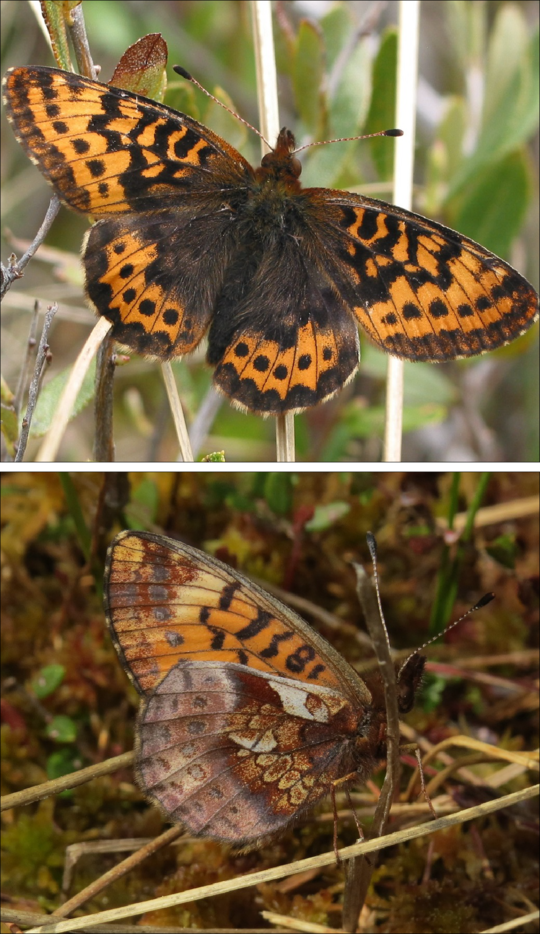 Frigga Fritillary (Boloria frigga). Photo by Kyle Johnson.
Frigga Fritillary (Boloria frigga) usually starts to fly in late May (overlapping with Freija Fritillary and Red-disked Alpine), and often has a very brief flight, with patrolling males flying within a week’s window in hot weather. They like ribbed fens, spring fen channels, ovoid islands, and edges of raised bogs where bog willow (Salix pedicellaris) grows. Frigga Fritillary has been found in the East Rat Root River Peatland, Lost Lake Peatland, Lost River Peatland, Luxemberg Peatland, Mulligan Lake Peatland, North Black River Peatland, Pine Creek Peatland, Red Lake Peatland, Sand Lake Peatland, Sprague Creek Peatland, Wawina Peatland, West Rat Root River Peatland, and Winter Road Lake Peatland.
 Jutta Arctic (Oeneis jutta). Photo by Kyle Johnson.
Jutta Arctic (Oeneis jutta) – pronounced YOU-tuh –takes flight soon after Frigga Fritillary, usually late May to early June, and lasts for 2-3 weeks. They are biennial, meaning it takes 2 years to complete development from egg to adult butterfly (a common strategy for high latitude species, where growing seasons are short). In Minnesota, adults fly only in odd numbered years in some places, even-numbered years in others, and both years in still others. They like forested peatlands, ranging from semi-treed spruce-tamarack bogs to shady black spruce rich swamps. Jutta Arctic has been found in the East Rat Root River Peatland, Lost River Peatland, Mulligan Lake Peatland, North Black River Peatland, Pine Creek Peatland, Red Lake Peatland, Sand Lake Peatland, Sprague Creek Peatland, Wawina Peatland, and West Rat Root River Peatland.
 Taiga Alpine (Erebia mancinus). Photo by Kyle Johnson.
Taiga Alpine (Erebia mancinus) is the most elusive of our boreal peatland butterflies. It inhabits old-growth black spruce poor swamps, rich swamps, and forested bogs with large pole-like trees (usually over 30 feet tall) and is very fussy about the vegetative details of its domain. It often shares it shady home with the more widespread Jutta Arctic and has a similar flight period. Taiga Alpine is likewise biennial, with most sites on either even or odd year cycles. While mature black spruce peatlands are common in northern Minnesota, Taiga Alpine uses only a very small percentage. The Sand Lake Peatland is the only SNA known to harbor this species, where it flies in odd-numbered years. Further surveys in other SNA’s (especially the East and West Rat Root River Peatlands) might yield additional populations.
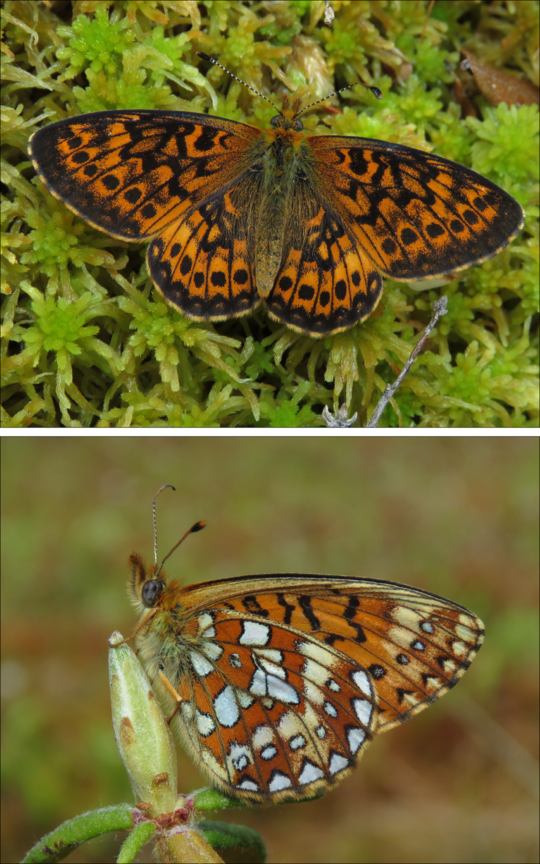 Bog Fritillary (Boloria eunomia). Photo by Kyle Johnson.
Bog Fritillary (Boloria eunomia) appears in the midst of the Jutta Arctic flight, typically in mid to late June. Like Frigga Fritillary, the Bog Fritillary can have a very short flight, with the main flight of patrolling males over within a week in hot weather. It likes wet sites with lots of cranberry, including quaking Sphagnum mats around lakes, ribbed fens, spring fen channels, and the edges of raised bogs. Bog Fritillary has been found in the East Rat Root River Peatland, Lost River Peatland, Luxemberg Peatland, Mulligan Lake Peatland, North Black River Peatland, Pine Creek Peatland, Red Lake Peatland, Sand Lake Peatland, Sprague Creek Peatland, Wawina Peatland, West Rat Root River Peatland, and Winter Road Lake Peatland.
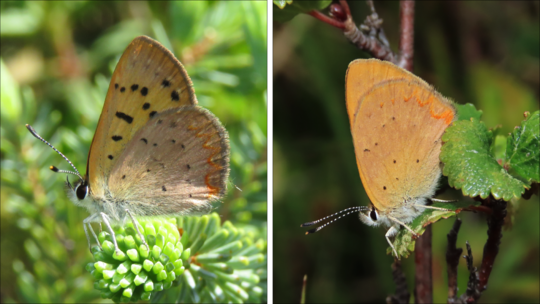 Dorcas Copper (Lycaena dorcas). Photo by Kyle Johnson.
Dorcas Copper (Lycaena dorcas) is a mid-summer species, beginning in late June (rarely overlapping with the last worn Bog Fritillaries) and persisting into August, depending on location. It frequents a variety of peatlands, from raised bogs to spring fen channels. It also occurs in wet brush prairie with shrubby cinquefoil (Dasiphora fruticosa) in the Tallgrass Aspen Parklands province. Adults often visit flowers, including those in adjacent roadsides. Dorcas Copper has been found in the East Rat Root River Peatland, Lost River Peatland, Mulligan Lake Peatland, North Black River Peatland, Pine Creek Peatland, Red Lake Peatland, Sand Lake Peatland, Sprague Creek Peatland, Wawina Peatland, West Rat Root River Peatland, and Winter Road Lake Peatland.
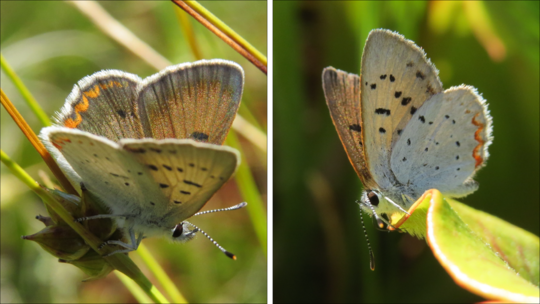 Bog Copper (Lycaena epixanthe). Photo by Kyle Johnson.
Bog Copper (Lycaena epixanthe) usually takes flight in early July, and persists into August. It often flies in the company of Dorcas Copper, but is more habitat restricted to wetter peatlands with abundant cranberries. In the northwest, it is particularly fond of ribbed fens, spring fen channels, ovoid islands, and raised bogs with internal water tracks. In that part of the state, it is often lacking from drier raised bogs, including those with abundant cranberry. Bog Copper has been found in the East Rat Root River Peatland, Lost River Peatland, Mulligan Lake Peatland, Myrtle Lake Peatland, North Black River Peatland, Pine Creek Peatland, Red Lake Peatland, Sand Lake Peatland, Sprague Creek Peatland, Wawina Peatland, and West Rat Root River Peatland.
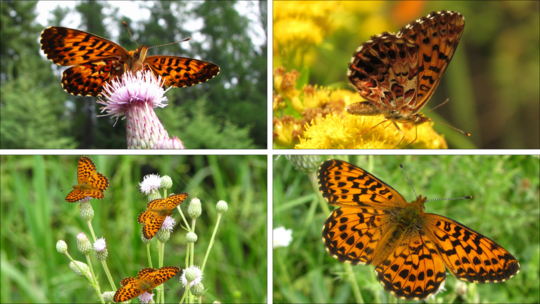 Arctic Fritillary or Purplish Fritillary (Boloria chariclea). Photo by Kyle Johnson.
Arctic Fritillary or Purplish Fritillary (Boloria chariclea species complex – taxonomy in need of further study) is the last of the peatland specialist butterflies to emerge, usually beginning in late July and persisting through much of August. Although the breeding habitat includes forested bogs and black spruce rich swamps, adults readily nectar on flowers in adjacent uplands or roadsides, making them easier to observe than the other peatland fritillaries. Arctic Fritillary has been found in the East Rat Root River Peatland, Lost Lake Peatland, Mulligan Lake Peatland, Myrtle Lake Peatland, North Black River Peatland, Pine Creek Peatland, Red Lake Peatland, Sand Lake Peatland, Sprague Creek Peatland, Wawina Peatland, and West Rat Root River Peatland.
Back to top
|
|

Site Highlight: Cottonwood River Prairie SNA
Ashley Rezachek, SNA Communications Outreach Specialist
|
It was a late May morning when we arrived at Cottonwood River Prairie Scientific and Natural Area in Brown County, Minnesota. Stepping out of the truck, we were greeted with a breeze of wind and a bright green prairie with small hills dotted with lichen-covered rocks. This is where we would start our journey, a journey dedicated to exploring Minnesota’s most natural areas. By the end of the long day, we had walked many miles, identified multiple native plant species, snapped hundreds of photos, and removed a dozen or so ticks from our clothes!
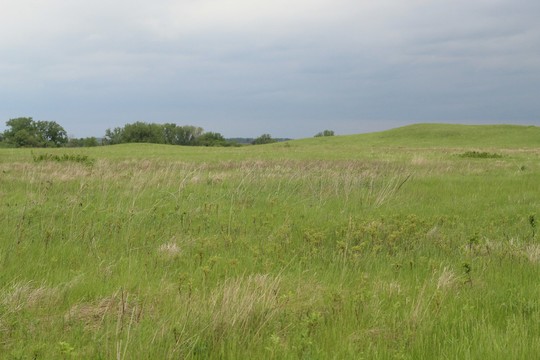 Cottonwood River Prairie SNA was established as an SNA in 1991 and to this day provides habitat for a variety of native prairie species. Photo by Ashley Rezachek.
Cottonwood River Prairie SNA includes three continuous management areas; the Prairie Champion unit to the west, the Prairie Sky unit to the east, and the narrow Railroad Prairie connecting the two. We started our visit at the western unit where wet prairie, mesic prairie, and dry sand-gravel prairie habitats are found. This 347-acre SNA is an ideal location to watch wildlife, hike, snowshoe, cross-country ski, and take photos.
DNR staff treated a patch of prairie in the western unit with a prescribed burn earlier this year. This common management practice left a section of the landscape browned and charred. Small wildflowers and grasses were popping up here and there among the burnt vegetation, and pollinators were already working hard moving from flower to flower. Burning in patches creates a mosaic of habitats that support a variety of plants and animals. Native plants have evolved with fire, and prairie wildflowers and grasses grow more vigorously following a prescribed burn.
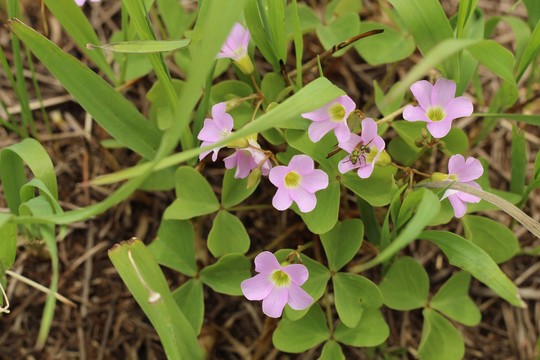 Violet wood sorrel popped up in the burned area of Cottonwood River Prairie SNA. Photo by Ashley Rezachek.
Not far beyond a small hill was a pond, where birds perched on nearby vegetation and turtles basked on a log near the pond’s edge. Careful not to step into a burrowed hole, my dad and I continued our exploration, pointing out many interesting finds before looping back to the truck. With almost a year’s worth of natural resource knowledge and having just completed my Master Naturalist course, I was excited to share what I knew about Minnesota’s natural areas with my dad and work together to find and identify as many species as we could.
There was one prairie wildflower in particular that I was hoping to see and show my dad, but I wasn’t having much luck finding it. Slightly bummed about not being able to find this strange-looking flower on the western unit and increasingly more curious about what the eastern unit had in store, my dad and I hopped back in the truck and made the short drive over to Prairie Sky. One thing I noticed right away about this unit was the rise in terrain. This unit offered many opportunities for impressive views of the expansive prairie below!
 A deer at Cottonwood River Prairie SNA looks directly at us as we make our way into the prairie. Photo by Ron Rezachek.
As we hiked into the unit, we spotted a deer traveling through the prairie. It watched us for some time before bouncing away just as we reached the base of a hill. As we began to climb the hill, there it was! The wildflower I had hoped to see – prairie smoke! I wanted to find this unique wildflower so I could show it to my dad. I had described its red flowing “hair” and had mentioned that it reminded me of Dr. Seuss’ fictional Truffula trees from The Lorax.
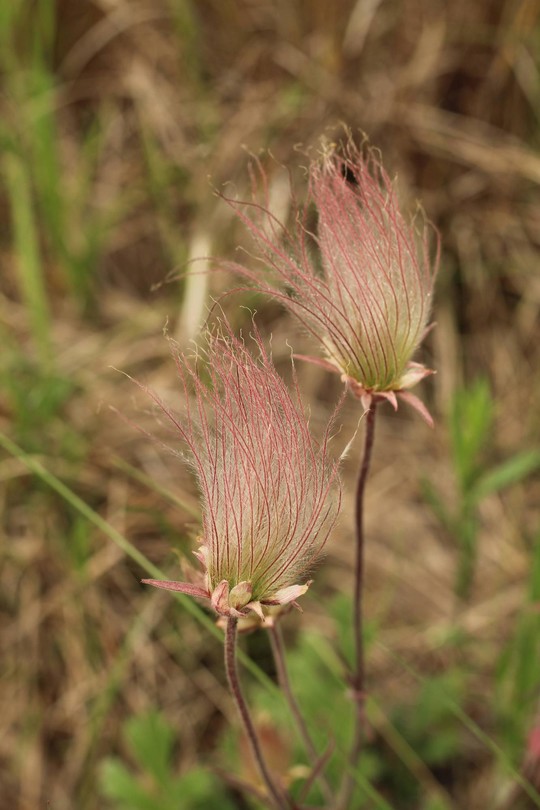 Prairie smoke, also known as “Old Man’s Whiskers” can reach heights of 6 to 16 inches. These native wildflowers can typically be found blooming April through June. Photo by Ashley Rezachek.
Soon we were wandering up and down the hills, finding so many species of colorful wildflowers. With a camera in one hand and iNaturalist pulled up on our phone in the other, we identified a variety of plants including prairie blue-eyed grass, pasqueflower, blazing star, hoary puccoon, horsetail, and many more.
Through my exploration of prairies and during my time with the Department of Natural Resources, I’ve grown to appreciate prairie and the abundance of wildlife it supports. Prairie once covered a little over a third of the state, about 1,888,000 acres. Today, our state’s prairie communities cover about 250,000 acres or about 1–2 percent of their historical area, and much of what remains is degraded or threatened. Prairie has been identified as one of the most threatened ecosystems in North America, which makes conservation of prairie habitat important!
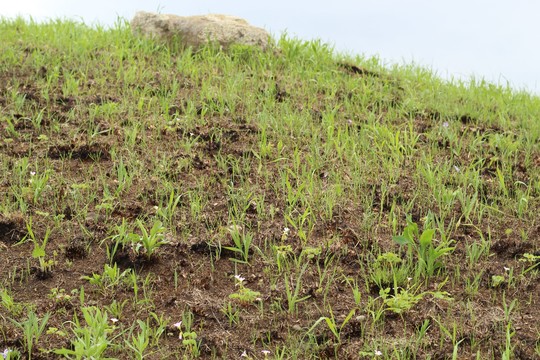 Grasses and plants grow back in the burned unit of Cottonwood River Prairie SNA. Photo by Ashley Rezachek.
The Railroad Prairie unit is an example of the association between prairie conservation and railroad corridors. The uncultivated right of way provided safety for native species to grow. Today most of the infrastructure is gone, but the trestles remain. We didn’t get a chance to explore the railroad prairie unit before we had to head back. On our way home we stopped at Chamberlain Woods SNA and Savage Fen SNA. By the end of our nearly 9-hour SNA exploration, we saw columbine, wild blue phlox, pheasant back mushrooms, a garter snake, a turkey, and a snapping turtle, among many other plants and animals. Getting to explore Minnesota’s diverse and unique habitats was such a treat!
Back to top


Say Hello to the New Northeast Region - East District Manager!
Cliff Bentley is the new Northeast Region - East District Manager. He supervises the Ecological and Water Resources (EWR) Division’s water resource, nongame and SNA programs. He started with DNR as an intern in college in 1989. He was hired full-time as a hydrologist in 1992, and recently became District Manager with EWR in the Northeast Region in January 2022.
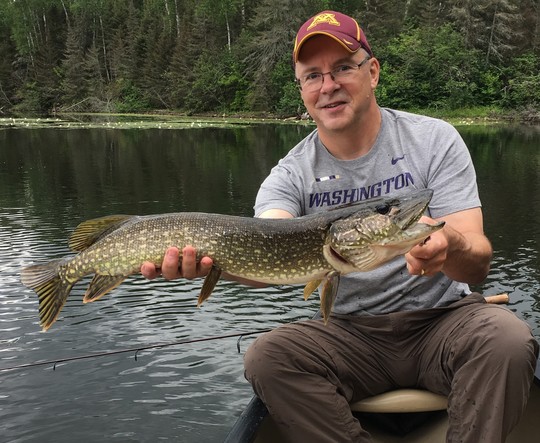
What gets you excited about your work?
I love knowing that what I do as part of the DNR team helps to manage and conserve all the wild, natural things that define Minnesota. After living in many places all over the country, Minnesota is the place I chose to live and raise my family. Our state’s diversity of ecosystems and natural features, from trout streams to walleye lakes, prairie wetlands to boreal forests, 10,000 lakes to the ocean-like coast of Lake Superior, offers lifestyle opportunities and a range of recreational activities that are hard to equal. People identify Minnesota with the prairies, woods, waters and wildlife that attracted me to adopt this as my home. It means a lot to play a part in keeping the state uniquely Minnesotan.
What is your favorite way to spend time outdoors?
Most of my time growing up was spent outdoors, either doing activities with family or friends or simply wandering around on my own just finding what I could find. I enjoyed being outside smelling the smells, seeing the sights, hearing the sounds, and feeling the earth and air. The number of activities that I enjoyed then, and still enjoy now, make it hard to choose a single favorite. The common thread, though, was never knowing what the day would bring. Because of that, my favorite outdoor activities involve hunting and fishing because I never know what I might find. I enjoy following my bird dog through the woods or paddling a canoe along a shoreline with a fishing pole because something exciting could happen at any moment, even if it’s not what I intended. I can’t count the number of times I came home empty-handed from fishing or hunting feeling like I had the best day ever because I saw a wolf or had a beaver swim under my canoe. Hunting and fishing take me to the places I wouldn’t otherwise go, so I can experience interesting things I wouldn’t otherwise get to smell, see, hear and feel.
What is your favorite SNA?
Choosing a favorite SNA is like asking a teacher to pick their favorite student. All of them are great, and they each have unique, individual characteristics that make them special. I haven’t been to all of the SNAs in the Northeast Region, but every time I visit a new one, I think I’ve found a new favorite. Unlike a teacher who may have a difficult student to deal with, however, there isn’t a single SNA that I don’t like. Each is a favorite in its own way, so there could be a different answer any day this question is asked but, for today, my favorite SNA is Iona’s Beach because it’s an iconic rocky shoreline that perfectly expresses the character of Lake Superior’s North Shore and is a wonderful summer spot to relax while watching and listening to the lake.
Back to top
Connect with Other Prairie Landowners
Are you looking for a way to connect with other prairie landowners, discuss management ideas, and ask questions?
The Minnesota Prairie Landowner Network is an online community dedicated to helping you manage your prairie. Join over 700 landowners and prairie professionals to share photos, ask questions, and offer advice.
Check out the recent publication of “Discover the Minnesota Prairie Landowner Network” which features just a few of the best topics from the Facebook group.
 Back to the top
Notes from Site Stewards
Site stewards monitor SNAs across Minnesota. Their observations provide valuable information to the SNA Program. Here are some interesting notes from recent reports.
- A lark sparrow was spotted on April 30th at Mound Spring Prairie SNA by site stewards William and Esther Marengo. The lark sparrow is a species of special concern in Minnesota, with breeding populations in small sections of southeast and western Minnesota. This is the first time this species has been found at this site!
- Jerry Ibberson, Site Steward of Clinton Falls Dwarf Trout Lily SNA, is also a volunteer with the Minnesota Biological Survey (MBS). At one of his recent visits to the site with MBS, he documents both a white trout lily and a dwarf trout lily side by side, effectively comparing the size difference between the two species, according to his May 10th steward report.
- With the help of a couple of friends, Angie Begosh was able to fill up two whole bags of trash at Seminary Fen SNA on March 27th. Thanks for your hard work, Angie and friends!
- Mark Erickson made a visit to Minnesota Point Pine Forest SNA on March 27th and noted the interpretive sign had fallen and a tree over the trail was about to come down too. Thanks to his timely observation, we were able to go out on the site the next day to fix them.
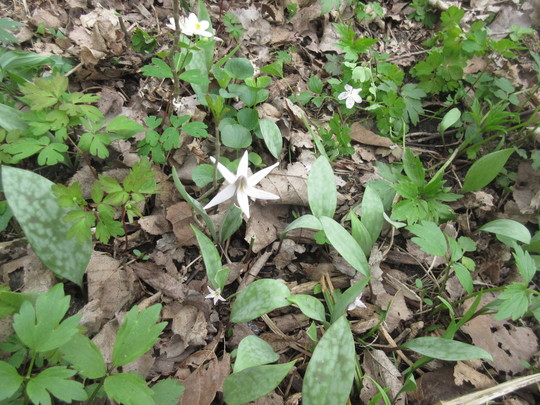 Size comparison between white trout lily and dwarf trout lily at Clinton Falls Dwarf Trout Lily SNA. Photo by Jerry Ibberson.
Back to top

SNA Events
This summer we are excited to have several events lined up, both in-person and “self-guided!” Check out the SNA Events page for the most up-to-date event information. We've also re-started SNA event reminders, so sign up to get weekly reminders of upcoming events.

|
|
|
Nature Notes is the Minnesota Scientific and Natural Areas quarterly newsletter (archive online). It seeks to increase interest, understanding and support of natural areas while promoting involvement in the protection of these special places. Contact us directly at sna.dnr@state.mn.us.
Funding for this project was provided by the Minnesota Environment and Natural Resources Trust Fund as recommended by the Legislative-Citizen Commission on Minnesota Resources (LCCMR).
|
|
|
|